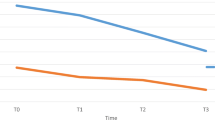Abstract
This qualitative study sought to provide a deeper understanding of the experiences of college women who had been bullied while in middle school and/or high school. In-depth interviews were conducted with 12 college women between the ages of 18–23 who were asked to describe the bullying behaviors they experienced, the impact it had on them at the time, and the ongoing impact it has had on their college experience. All the women shared stories of being bullied by other girls. The bullying behaviors experienced were divided into four categories: verbal, physical, exclusion, and cyberbullying. When describing the impact, the most common themes were negative emotional responses (including experiencing anxiety, feeling very alone, having a very low sense of self, and fears of making friends or trusting new people), as well as avoidance (avoiding extracurricular events, certain classes, cafeteria). Most stated that, particularly in their first year of college, they felt the ongoing negative emotional impact of being bullied, in terms of social anxiety and a lack of self-confidence, however they also talked about the positive gains and growth they had made by overcoming being bullied. Recommendations for what middle school and high schools, as well as parents, can do to work to reduce bullying behaviors are discussed.
Similar content being viewed by others
Data Availability
Not applicable.
References
Braun, V., & Clarke, V. (2006). Using thematic analysis in psychology. Qualitative Research in Psychology, 3, 77–101.
Cohn, A. & Canter, A. (2014). Bullying: Facts for schools and parents. NASP Fact Sheet. https://www.naspcenter.org/factsheets/bullying_fs.html. Accessed 15 May 2022
Cowie, H. (2011). Coping with the emotional impact of bullying and cyberbullying: How research can inform practice. The International Journal of Emotional Education, 3(2), 50–56.
Creswell, J. (2007). Qualitative inquiry and research design: Choosing among five approaches. Sage Publishing, Inc..
Gruber, J., & Fineran, S. (2008). Comparing the impact of bullying and sexual harassment victimization on the mental and physical health of adolescents. Sex Roles, 59(1/2), 1–1.
Hinduja, S., & Patchin, J. W. (2013). Social influences on cyberbullying behaviors among middle and high school students. Journal of Youth and Adolescence, 42(5), 711–722.
Hornor, G. (2018). Bullying: What the PNP needs to know. Journal of Pediatric Health Care, 32(4), 399–408.
Kann, L., McManus, T., Harris, W. A., Shanklin, S. L., Flint, K. H., Queen, B., et al. (2018). Youth risk behavior surveillance – United States, 2017. MMWR Surveillance Summary, 67(8), 1–114.
Lipson, J. (2001). Hostile hallways: Bullying, teasing and sexual harassment in school. American Association of University Women Educational Foundation.
McDougall, P., & Vailliancourt, T. (2015). Long-term adult outcomes of peer victimization in childhood and adolescence: Pathways to adjustment and maladjustment. American Psychologist, 70, 300–310.
Mikel Brown, L. (2005). Girlfighting: Betrayal and rejection among girls. New York University Press.
Musu, L., Zhang, A., Wang, K., Zhang, J., & Oudekerk, B. (2019). Indicators of school crime and safety: 2018. National Center for Education Statistics, U.S. Department of Education, and Bureau of Justice Statistics, Office of Justice Programs, U.S. Department of Justice.
Nansel, T., Overpeck, R., Pilla, W., Ruan, P., Scheidt, K., & Simons-Morton, B. (2001). Bullying behaviors among US youth: Prevalence and association with psychological adjustment. JAMA, 285(16), 2094–2100.
Silva, M. A., Pereira, B., Mendonça, D., Nunes, B., & de Oliveira, W. A. (2013). The involvement of girls and boys with bullying: An analysis of gender differences. International Journal of Environmental Research and Public Health, 10(12), 6820–6831.
Stopbullying.gov. (2021). What is the definition of bullying? US. Department of Health and Human Services. https://www.stopbullying.gov/. Accessed 15 May 2022
UNESCO (2019). Behind the numbers: Ending school violence and bullying. https://unesdoc.unesco.org/ark:/48223/pf0000366483. Accessed 15 May 2022
Wolke, D., Copeland, W. E., Angold, A., & Costello, E. J. (2013). Impact of bullying in childhood on adult health, wealth, crime, and social outcomes. Psychological Science, 24(10), 1958–1970.
World Health Organization (2012). Social determinants of health and well-being among young people. Health behaviour in school-aged children (HBSC) study: International report from the 2009/2010 survey. Health policy for children and adolescents, no. 6. https://www.euro.who.int/__data/assets/pdf_file/0003/163857/Social-determinants-of-health-and-well-being-among-young-people.pdf. Accessed 15 May 2022
Author information
Authors and Affiliations
Contributions
Both authors contributed to the study conception and design. Material preparation, data collection and analysis were performed by Katelyn F. Smith as part of her research, with the support of her advisor: Sandra L Caron. The first draft of the manuscript was written by Katelyn with the assistance of her advisor Dr. Caron. Both authors read and approved the final manuscript.
Corresponding author
Ethics declarations
Conflicts of Interest/Competing Interests
On behalf of both authors, the corresponding author states that there is no conflict of interest.
Ethics Approval
This is to confirm that the research complies with ethical standards.
Consent
Informed consent was obtained from all individual participants included in the study.
Additional information
Publisher’s note
Springer Nature remains neutral with regard to jurisdictional claims in published maps and institutional affiliations.
Rights and permissions
About this article
Cite this article
Smith, K.F., Caron, S.L. Exploring the experiences and impact of middle school and high school bullying: A qualitative analysis of interviews with college women. Curr Psychol 42, 21505–21517 (2023). https://doi.org/10.1007/s12144-022-03267-9
Accepted:
Published:
Issue Date:
DOI: https://doi.org/10.1007/s12144-022-03267-9




